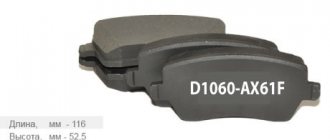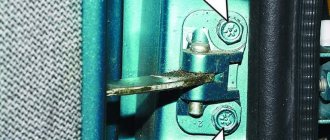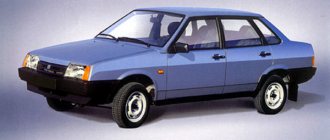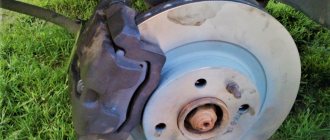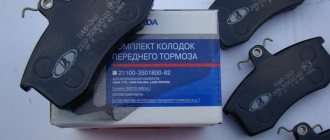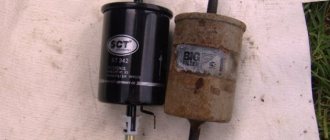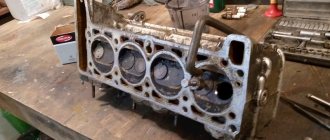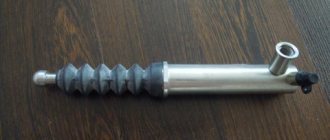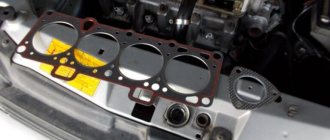The brake system of a car requires timely monitoring to identify possible faults and must be checked every six months.
| Standard brake pipe repair kit for VAZ 2110. |
It is best to time it to coincide with the end of the winter period, as it is the most difficult to operate. In winter, the road surface is treated with chemicals that have an aggressive effect on all elements of the body, including the brake system.
When checking the brake system, you need to check the condition of the brake fluid pipelines, brake hoses, their fastening, as well as the condition of the brake pads. At the same time, cracks, abrasions of the outer coating, swelling, leakage of brake fluid and other damage are not allowed on the brake pipes.
It is advisable to carry out the test using a powerful lamp and a mirror so that any malfunction can be identified. Timely replacement of worn-out brake system components will guarantee your safety.
If damage to the brake hoses or pipelines is revealed during the inspection, then a mandatory replacement of the VAZ 2110 brake pipes and hoses will be required.
Most often, you have to change brake hoses after a certain mileage, namely in the region of 70-100 thousand kilometers, or when a malfunction is detected. Brake pipes last quite a long time and replacement of VAZ 2110 brake pipes occurs when they are corroded or mechanically damaged.
To replace, you need to purchase a set of VAZ 2110 brake pipes. In this case, you can purchase either brake pipes already bent to the desired configuration, or simply straight ones, which will need to be given the profile of the removed brake pipes.
| Video of replacing brake pipes on front-wheel drive VAZ cars. After watching this video, we can say that replacing brake pipes on a VAZ 2110 at home is not particularly difficult. |
It is better to purchase ready-made (factory bent) tubes, which will significantly simplify the process of replacing them.
If you purchase straight brake pipes, you will need a tool to bend them (you can use a spring with a suitable internal diameter where the pipe should fit when bent). Steel double-layer brake pipes are more reliable.
It will be more economical to purchase an unmolded copper line, but you will need to bend it yourself, observing all the necessary dimensions, which will require more time to replace.
To work, you will need an inspection hole or overpass. Carrying out the replacement simply on a level surface with the help of a jack is also possible, but it is quite labor-intensive and dangerous in terms of work safety.
To replace faulty brake hoses or tubes, you will need a special wrench for working with the VAZ 2110 brake system, as an addition and a gas wrench (first number) for disconnecting the fittings on the master brake cylinder, working cylinders, as well as in the brake hose connections.
It is also necessary to have a set of wrenches for: 10, 13/14, 17 mm, composition VD 40 or similar and new brake fluid.
The procedure for replacing brake pipes on a VAZ 2110
- Before starting the replacement, you need to disconnect the terminal from the battery for safe work;
- Replacement of brake pipes must be done starting from the main brake cylinder in turn to each wheel cylinder;
- The wheel bolts are loosened and the car is jacked up to a convenient height for work;
- The brake pipe fittings are removed one by one from the brake master cylinder and the holes are closed with plugs;
- The pipeline is carefully released from plastic and metal fasteners towards a specific wheel. The protective plastic box must be removed;
- The brake hose fitting on the wheel is unscrewed, where the tube is replaced and the damaged line is removed;
- The new brake pipe is installed in the opposite direction, “going” from the wheel to the brake master cylinder;
- All tube holders are put back into place; those damaged during dismantling are replaced with new ones;
- The new pipeline is blown through with compressed air and connected.
Reasons for replacement
Brake hoses are designed to carry brake fluid from the master cylinder, through the brake lines, to the brake wheel cylinders under high pressure and temperature. They work constantly in moving suspension elements, therefore they are made elastic from a rubber compound.
The main reasons for replacing brake hoses on a VAZ 2110 car are:
- the presence of cracks on the outer part during bending;
- abrasions on suspension elements;
- brake fluid leaking from the splined joints of the tube;
- in more rare cases, a defect may occur as a result of a foreign body entering while driving on the road (crushed stone, stones, snow, ice, etc.);
- Also, in exceptional cases, the inner part of the hose peels off (it is not possible to detect it visually), in this case a blockage occurs inside and liquid does not pass through it; it is revealed during dismantling.
This material will help you understand the brake system: https://vazweb.ru/desyatka/tormoza/tormoznaya-sistema.html
When is it necessary to replace pipes and other elements of the brake system?
Brake pipes are changed quite rarely. The need for this arises only if the machine has been in use for a long time, in unfavorable conditions conducive to the development of corrosion, or in the event of any mechanical damage.
You can assess the condition of these components yourself by looking under the car body, or by bringing your “iron horse” for inspection by technicians from the service center. According to the regulations, diagnostics of all components of the brake system must be carried out at least once a year, preferably at the end of the winter period. You can combine the inspection with the next oil change.
Rubber hoses on all wheel cylinders must be replaced, regardless of their condition, every 70-100 thousand km. mileage Pipelines are replaced only as needed.
To carry out the work you will need the following tools:
- Jack;
- Phillips screwdrivers;
- Set of wrenches for: “10”, “14”, “17”;
- Clamping key to “10”;
- Clamping pliers;
- Balloon wrench;
- Anti-corrosion composition;
- Brake fluid (to replenish the system).
What to consider?
The design of the brake system and the principle of its operation are almost identical for all car models. Accordingly, the method of its restoration is also the same for all brands of vehicles.
All pipeline repair work can be carried out in a repair pit, overpass or on a flat area by lifting the machine with a jack.
A set of tubes can be purchased at any auto store. You can order a pipeline of a given length, already bent as required, specifically for a specific car model. Or you can buy a universal copper line, and then give it the required shape and length yourself. The latter option is more economical, however, and there is much more fuss.
The main stages of replacing brake pipes on a VAZ 2109, 2110
You can replace the pipeline lines in the direction from the main brake cylinder to each wheel according to the following diagram.
- Disconnect the battery terminals.
- Raise the car to the desired height using a jack.
- Remove the car wheels.
- Using a “10” wrench, unscrew the nut securing the tube to the master cylinder and install a plug for dust and dirt in the supply hole.
- Carefully release the pipeline towards the wheels. Remove the protective plastic box and remove the line from the metal and plastic holders. Try to do this carefully so as not to damage the clips.
- Unscrew the brake hose fitting and remove the damaged line.
- Start installing the new tube in the opposite direction: from the wheel to the master cylinder.
- Reinstall all holders, replacing worn or damaged parts as necessary.
- Blow out the pipeline with compressed air, connect it to the system and bleed the brake system according to the instructions, replenishing the missing fluid as necessary.
Nuances
If both tubes are being replaced, then bleeding must be done sequentially - the front right wheel, then the front left one.
When replacing the rear brake hose of a VAZ 2110, the replacement principle is the same, except that on the rear hose on both sides there is a 10-point fitting and a 15-point key. Also, to replace the rear hose, you need a pit or a lift (theoretically, you can replace it on the ground, but this extremely inconvenient).
When bleeding the entire brake system on a VAZ 2110, the algorithm is the same. But you will need to remove the rear wheels, and bleeding is carried out in the following order: rear left wheel, front right, rear right, front left.
Features of replacing brake hoses
When replacing brake pipes on a VAZ 2110, it is a good idea to check the condition of the elastic hoses. If you notice even minor cracks and mechanical damage on them, replace them. Also install new hoses if the service life of the old ones has already exceeded the required limit.
The elastic hose replacement scheme consists of the following steps:
- Clean the cylinder well with a wire brush, treating it with rust remover if necessary;
- Using a “14” wrench, unscrew the wheel caliper fitting;
- Plug the caliper hole to prevent dirt from getting into it;
- Using wrenches “17” and “10”, unscrew the fitting and disconnect the hose from the tube;
- Remove the elastic hose holder;
- Install the new hose in sequence from tube to caliper.
Replacing the brake system elements described above is not a very pleasant matter. However, if you are going to replace the piping and hoses, be glad that you won't have to do it anytime soon.
The brake system appeared on the first cars. Its presence has become the key to the safety of the driver and passengers. The first brake system did not have a complex mechanism of action and consisted of several mechanical parts that created the necessary friction on the wheel drive for its subsequent stopping.
The second stage in the development of the braking system was the application of the laws of hydraulics. With this method of braking, the interaction between the brake pedal and the working parts of the brake system is carried out using a special fluid called “brake fluid” (or abbreviated as TF). Brake fluid allows you to stop your vehicle more efficiently. In addition, the use of brake fluid softened the pressure on the brake pedal and made driving more comfortable.
For successful circulation of brake fluid from the brake drive system to the working parts, it is carried out through special pipes. Initially, they were made in the form of hoses, but since they were unreliable, they were replaced by another material.
Which brake hoses should be installed on a VAZ 2110 and when should they be changed?
Original number 21103506060, average price about 288 rubles.
- TRIALLI BF110 — 165 rub.
- FENOX PH21101C3 — 179 rub.
- HOLA HV110 — 200 rub.
Replacement is recommended every 4-5 years (or 50 thousand km). The frequency of inspection is every six months.
If you don’t want to contact service center specialists, you can figure out for yourself how to replace brake hoses on a VAZ 2110, and then evaluate your strengths and capabilities in order to begin repairs. The main thing is to understand all the risks and not be afraid of unforeseen situations. Be sure that replacement of small auxiliary parts will be necessary sooner or later, and there is no point in delaying repair or maintenance work
Firstly, if one part fails, it can provoke a decrease in the level of functionality of another, no less important component in the technical system of the car. Secondly, any deformation of parts, their “boiling”, damage can lead to the undesirable effect of uncontrollability of the car
Just imagine what can happen if a vehicle's brakes malfunction! It is better not to let the car you have at your disposal fall into this state; you should think in time about how to replace the brake hoses of a VAZ 2110 and what you will need for this.
Brake hoses for VAZ 211
Let us remember that the main task of the hoses is to supply brake fluid from the main brake cylinder located in the hood to the working brake cylinders at the wheels. And everything is carried out under considerable pressure and at a fairly high temperature. The hoses are interconnected with moving suspension elements, and therefore are made of wear-resistant rubber, but hoses cannot be called eternal, so sooner or later you will have to decide how to change the brake hoses on a VAZ 2110, and whether it is worth doing it yourself.
Design and principle of operation of brake pipes
The car is braked by pressing the brake pedal. The pedal lever acts on a vacuum or any other booster, which creates the necessary pressure on the brake fluid. The liquid compresses and goes into a zone where this pressure is minimal. It enters the brake pipes, through which it is directed to the working parts of the brake system. The fluid puts pressure on the brake pads, causing them to compress. When you release pressure on the brake pedal, the pressure in the booster decreases, and the spring drive of the brake pads unclenches them and sends the fluid back to the booster (the area of least pressure).
The passage of liquid is carried out through tubes made of metal. The tubes extend from the vacuum booster and are laid under the car to the working parts of the brake system. The joints of the tubes are made in the form of threaded connections, which makes it possible to achieve maximum reliability when creating high pressure in the system.
To increase the reliability of the braking system, the pipes are connected diagonally, which allows the brakes to be used if one of the lines fails. So, for example, from the vacuum booster, one tube connects the working part of the brakes of the front left and rear right wheels, and the second tube directs the brake fluid to the front right and rear left wheels. At the junction of all four pipes, a special pressure regulator is installed, which filters out excess pressure from the system so that it does not cause a breakthrough in the lines.
Scheme for pumping brakes on a VAZ-2110
The brake system of the VAZ-2110 has two circuits operating in a diagonal pattern. This dictates the procedure for removing air from the system. When performing work, it is necessary to follow the following pumping sequence:
- Right rear wheel.
- Front left.
- Rear left.
- Front right.
The procedure for bleeding the brake system of the VAZ-2110 and modifications.
Necessary materials
Before you start bleeding, you need to stock up on brake fluid for topping up.
We stock up on brake fluid of a certain brand, and if the brand is not known to us, we prepare for its complete replacement.
It is important to remember that the liquid must be the same brand that was used previously. If we are not sure what kind of brake fluid is poured into the VAZ-2110 system, it is better to play it safe and replace it completely
Otherwise, when mixing fluids of different types, clots may form in the system, which will damage the brakes.
Also for work you will need a transparent container half filled with liquid, a hose for the fitting about 40-50 cm long, and a socket wrench with a cut out segment (union wrench).
Bleeding the brakes with an assistant
An assistant will be needed. Go.
- Open the lid of the fluid reservoir and add it to the maximum allowable mark. Add brake fluid to the reservoir.
- Clean the wheel brake mechanism and remove the protective rubber cap. Remove the protective cap from the fitting of the right rear wheel.
- If the car is installed on a lift (the wheels are in a suspended position), we block the rear brake pressure regulator. To do this, simply insert any plate or suitable screwdriver between the piston and the support heel. Block the "sorcerer" if necessary.
- We put the hose on the fitting, lower the second end of the hose into a container with liquid. We put the hose on the fitting, connect it to the container and pour brake fluid into it.
- We ask the assistant to smoothly and slowly press the brake pedal five to seven times, maintaining an interval of 2-3 seconds. The pedal is fixed in the lower position.
- At this time, we unscrew the fitting half a turn and release liquid with air bubbles into the vessel.
- We tighten the fitting, after which the assistant releases the pedal.
- Check the brake fluid level in the reservoir and add if necessary.
- We repeat the process until no more air bubbles are released.
- Remove the hose, wipe the fitting and put on the cap. We bleed the remaining brake mechanisms in order of priority.
Next, we bleed the brake mechanisms of the remaining wheels, according to the bleeding order.
We pump the brakes ourselves, without an assistant
If you couldn’t find an assistant, no problem.
To bleed the brakes alone, you will need a reservoir cap, a hose and a tubeless tire nipple.
We'll bleed it ourselves, but to do this you need to stock up on an old-style brake reservoir cap, without a fluid level indicator. You will also need a regular nipple from a car camera and a 14mm drill. Drill a hole in the center of the cover and insert the nipple. The device is ready. Let's move on to pumping:
- Add liquid to the tank to the maximum.
- We close the tank with our lid with a nipple. Screw the cap and gasket onto the tank.
- We take the spare tire and connect the spare tire nipple to the reservoir nipple with a hose. Thus, pressure on the liquid in the system is ensured. The pressure reserve in the wheel is more than enough to completely pump the system. In this case, it is undesirable to exceed the pressure of one atmosphere. Instead of a spare tire, you can use a pump or compressor, but still monitor the pressure. We attach the other end of the hose to the camera nipple.
- The procedure and procedure for bleeding is no different from removing air from the system with the help of an assistant. In addition, you also need to carefully monitor the fluid level so that the system does not trap air. For convenience, you can embed a faucet from the pneumatic system into the hose.
At the end of the work, check the fluid level in the tank; the pedal should be tight with minimal free play. Good luck, strong brakes and happy travels!
How to repair brake pipes
This process requires the car enthusiast to have extensive locksmith skills and the ability to use special tools. Repairs are carried out in cases where it is not possible to replace the damaged line; it involves saving money on the purchase of a new pipe system and extends the service life of the old one.
To carry out repairs you must:
1. Unscrew the damaged tube from the cylinder or brake caliper.
2. After disconnecting, it is necessary to cut off the damaged area using a pipe cutter.
3. Clamp the tube 50 millimeters from the edge of the cut and chamfer the edge of the tube using a drill.
4. Remove all that remains of the chips and insert a fitting intended for connecting the tube to the brake operating mechanism into the cut area.
5. Insert the end of the tube into the special equipment and flare it. The main line that has undergone repairs must be purged with compressed air. And only after this is it installed with a working mechanism or another pipeline system using an adapter.
As for the length of the tube, this parameter depends on the car model. On some cars, the brake pipes have a reserve that allows you to shorten the pipe and reconnect it to the working mechanism. The metal from which the brake tube is made is flexible, so there should not be any difficulties with its position.
